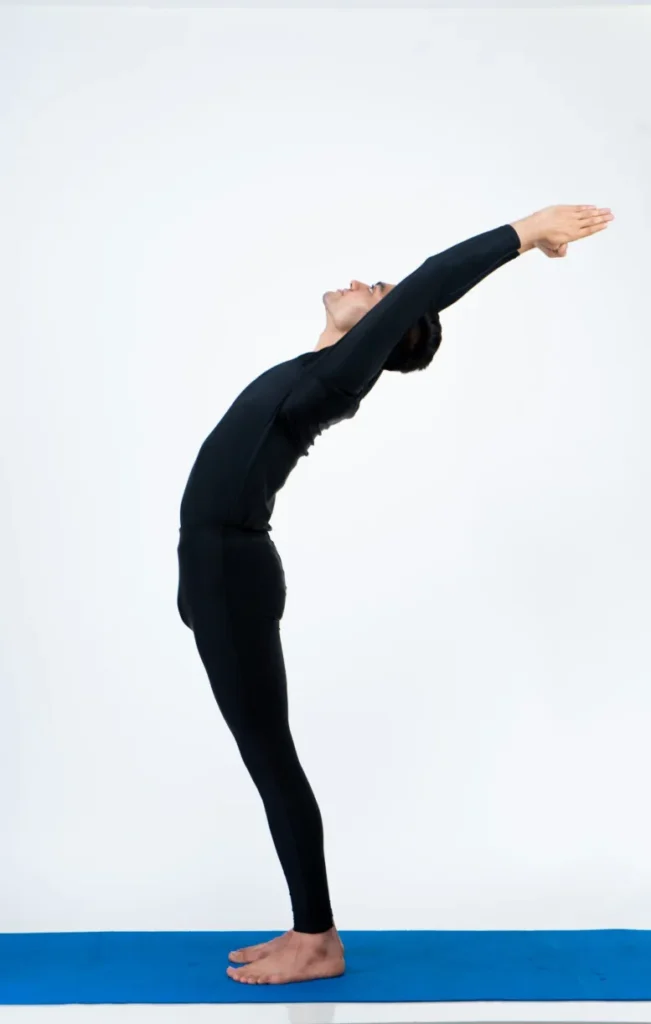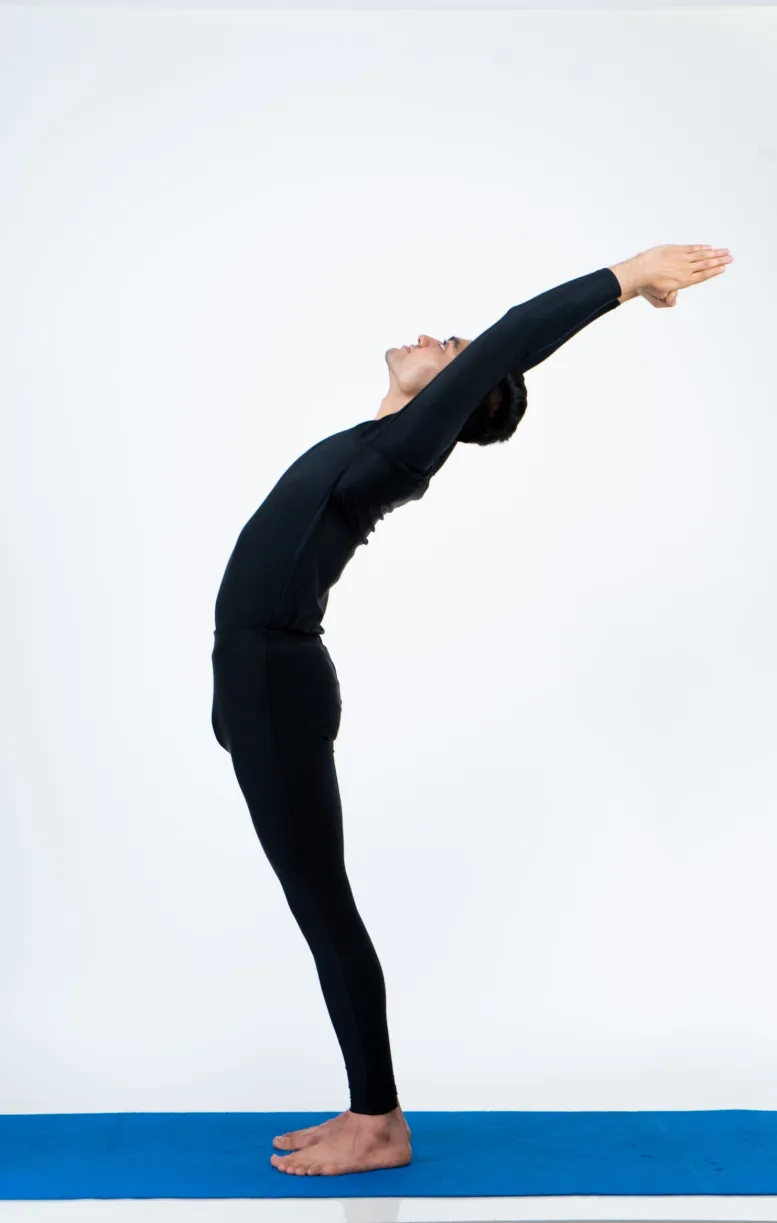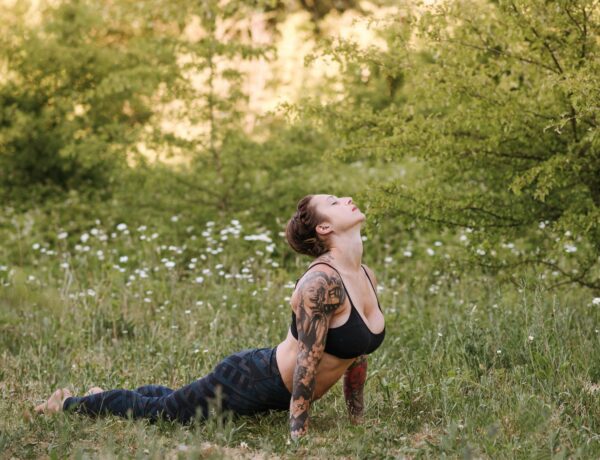
Introduction:
Hasta Uttanasana, also known as Raised Arms Pose, stands out as a basic backbend that provides several physical and mental advantages.
This beautiful position, which is frequently performed as part of the Surya Namaskar (Sun Salutation) sequence, energizes the inner fire, extends the entire front body, and develops the back muscles, making it an excellent complement to any yoga practice.
Table of Contents
ToggleThe Meaning of Hasta Uttanasana?
Hasta Uttanasana, derived from the Sanskrit words hasta (meaning “hand”), ut (meaning “intense”), tan (meaning “stretch”), and asana (meaning “posture”), literally translates to “intense hand stretch pose.”
This accurately depicts the deep stretch felt in the shoulders, chest, and belly during The pose
The Health Benefits Of Hasta Uttanasana?
Beyond the physical advantages, Hasta Uttanasana promotes pranayama (breath control) and dharana (concentration).
Here’s a deeper look at the various benefits of this position.
Physical Benefits:
Stretches and lengthens: The position stretches the whole front body, including the shoulders, chest, belly, hip flexors, and thighs. This helps both flexibility and posture.
Strengthens the back: Engaging the back muscles to maintain a modest arch in the spine strengthens the entire back, improves core stability, and prevents sagging.
Improves Circulation: The mild backbend increases blood flow throughout the body, boosting general health.
Hasta Uttanasana stimulates digestion by rubbing the abdominal organs, hence improving escape.
Increases Energy Levels: Opening the chest and deep breathing exercises can refresh the body and boost energy.
Mental and emotional benefits:
Include reduced tension and anxiety through appropriate alignment and breathing techniques.
Improves Mood: Opening up the chest and heart region will help you feel more happy and optimistic.
Boosts Confidence: Mastering this position may give you a sense of success and confidence in your talents.
How To Do It Hasta Uttanasana?
Step-by-Step Guidelines:
- Begin in Tadasana (Mountain Pose): stand tall with your feet hip-width apart and your weight equally distributed across both soles. Engage your core and raise your eyes slightly forward.
- Inhale and extend your arms upwards. Extend your arms upward, palms facing each other. Keep your shoulder blades down and away from your ears.
- Exhale and hinge at the hips: Gently fold forward from your hips, keeping your spine long and stretched. Reach your fingertips to the floor, or rest your palms flat on the ground if feasible.
- Lengthen your spine: Keep a modest arch in your lower back to minimize rounding. Engage your core to maintain your torso up and steady.
- Drop your head gently and gaze at your navel or the floor. Avoid straining your neck.
- Maintain deep, steady breathing throughout the position. As you hold the position, extend your inhale and exhale.
- Hold for 5–10 breaths. Hold the posture for as long as it feels comfortable, usually 5-10 breaths.
- Inhale to rise: To exit the posture, inhale and gradually raise your torso back to an upright position, one vertebra at a time.
- Relax in Tadasana: Take a few deep breaths to center yourself before moving on to the next posture.
Modifications:
Hasta Uttanasana does not allow everyone to effortlessly reach the floor with their hands. Here are a few changes to make the posture more accessible:
- Bend your knees: If reaching the floor is difficult, bend your knees as much as necessary to maintain a long spine.
- Use blocks: Place yoga blocks beneath your hands to provide extra support and lessen the severity of the stretch.
- Wrap a yoga strap over your wrists and hold it behind your back to increase the stretch in your shoulders and chest.
Safety precautions:
While typically safe for most people, there are a few precautions to take:
Avoid the posture if you have back problems, recent abdominal surgery, high blood pressure, or any other ailment that backbends might worsen.
Listen to your body. If you feel any pain or discomfort, get out of the posture immediately.
Seek advice. If you’re new to yoga and have any worries,
Frequently Asked Questions ?
Hasta Uttanasana, also known as Raised Arms Pose, is a basic backbend position in the Surya Namaskar sequence that causes deep stretch in the shoulders, chest, and abdominals.
To begin a yoga position, stand tall with feet hip-width apart, engage your core, and keep your spine neutral.
Inhale and reach up, keeping your arms straight and shoulder width apart.
Exhale and bend at the hips. Fold forward from your hips and extend your fingers to the floor.
Lengthen and activate your core muscles while avoiding rounding the spine. Breathe deeply and hold the stance for 5-10 breaths. Inhale to rise, then raise your torso back to an upright position while engaging your core and keeping a long, stretched spine.
Return to Tadasana and take deep breaths before proceeding to the next posture.
Hasta Uttanasana is a position that improves flexibility, core and back strength, circulation, digestion, energy levels, stress and anxiety reduction, mood elevation, and confidence building.
It entails extensive stretching of the front body, which promotes proper posture and prevents slouching.
The posture also improves blood flow, digestion, and energy levels through deep breathing. Mastering the posture can provide a sense of satisfaction and confidence.
Hasta Uttanasana (Raised Arms Pose) is usually considered safe for most people, however it should be used with caution in specific conditions.
Back injuries, severe high blood pressure, and recent abdominal surgery should avoid the position since it may put strain on recovering tissues.
Pregnant women should exercise cautious and alter their knees or head posture accordingly. Menstrual pain may necessitate adjustments, and ocular problems should prevent severe head pressure.
Knee injuries should be treated with modification, and headaches should be avoided. If you are unclear if a position is appropriate for you, listen to your body and get advice from a competent yoga instructor.





No Comments